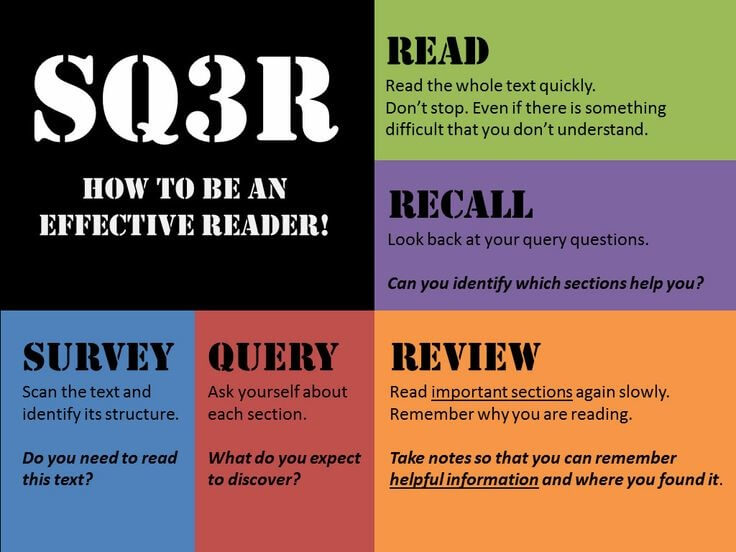Study Techniques: Having trouble studying? Can’t remember concepts you have studied recently? Don’t worry it happens to everyone and we have come up with 4 top study techniques that will make you a better learner to retain information that you have studied and eventually ace your exams. These are tried and tested methods and you can try to inculcate these in your daily study schedule.
The top 4 study techniques mentioned in this article to ace your exams are:
- Sq3R
- Feynman technique
- Pomodoro
- The ‘FAST’ Technique
1) SQ3R:
SQ3R is a study technique that helps one to find out the important information and focus on that. The name is an acronym that has five steps in total.

Survey:
This involves skimming through the chapters instead of reading and learning every single word. While doing this, you find out the purpose of the paragraph or notes. Write down important words, headings that you might need for reference later.
Question:
The “Q” stands for Question. Start generating and writing down any question that comes to your mind after skimming through the information. This is an important step of the process. In this step, you can write down the questions that you think are potential to be asked in a test or your exam. You don’t have to write down the answers, just jot down the questions.
Read:
Once you’re done with the questions, read the data again properly, this time pay attention to words and try to remember. Try answering the questions that you have jotted down for yourself. Answer the questions in an open book way, where you’re reading the question and the answer at the same time.
Retrieve or Recite:
Once you have read the information, try to close your book and then answer the questions closed book. If you are having trouble with a certain question, make sure you make a note of it so you can read it again later.
Also Read | Why is money management and investing important for college students?
Review:
Once you have finished the entire topic or chapter, keep reviewing the data often, you just have to look at the questions and make sure you’re able to answer them. Take quizzes related to the topic and test yourself.
This is an effective method because it doesn’t involve a lot of time in the sense that it doesn’t involve taking elaborate notes and making detailed handwritten flashcards or anything, it is just jotting down the questions and reviewing them.
2) Feynman Technique:
As the name suggests, this technique was developed by Richard Feynman who was a famous physicist. This technique suggests that you have to teach anything that you study to someone. If you have a younger sibling or a cousin then it is perfect.

There was a study that happened in a renowned university where some students had to learn the information, teach it to someone and then give a test and another group of students who had to simply study and give the test, the students who had to teach it did 90 percent better than the other students who didn’t have to teach the material they had learned.
The logic behind this is that when you learn some information and teach it to someone, you tend to retain the information better. To teach the information to someone, you first need to understand it completely without which you cannot teach a third person.
Feynman suggests that, when you try to explain to the person in simple words, you simplify the concept. The person encourages you in building a story around the concept that will eventually help you to understand the concept better.
If you don’t have a sibling or someone to teach, you can teach it to inanimate objects and the technique will still work.
Also Read | Top 5 Indian Podcasts in 2021 Every Youth Needs To Listen
3) Pomodoro technique:
Are you someone who gets distracted easily? Do you try to sit for long hours and are unable to do it? The Pomodoro technique is perfect for you.

Pomodoro was developed by Francesco Cirillo in the 1980s. Pomodoro means tomato in Italian and this name was coined because Francesco used his kitchen timer that looked like a tomato to implement this technique. To apply this technique to your daily life, we will give you the steps.
In this study technique.
- You decide on a topic or a chapter you want to study.
- After doing so, you set an alarm of 25 minutes and you get away from all the distractions and fully focus on studying that particular topic for 25 minutes.
- After 25 minutes, you take a 5-minute break. In this break, it is suggested that you get away from your workplace and take a short walk.
- After this 5 minutes, you again get to work for 25 minutes and continue this for 4 sittings, which comes up to 2 hours.
- After this, you can take a long break and get back and follow this technique until you finish the topic you have decided on.
To sum it up, it is 25 minutes of study with a 5 min break in between for 4 sittings. This is an effective technique because 25 minutes is not such a long period. So for people who get distracted easily, they have 5 minutes of break in between.
Also Read | Entrepreneurship: Why is this knowledge a necessity for College Students in India?
4) The ‘FAST’ technique:
This study technique was introduced by Jim Kwik who is an author, motivational speaker, and life coach. He is known for his speed learning techniques. According to Jim Kwik, if you want to learn anything faster, remember the word FAST.

▶ F stands for Forget. He suggests that you must forget everything you already know about the subject. A lot of people do not learn faster because they are in a delusion that they already know the topic or some part of it, so they are not completely able to grasp the topic.
Forget also means to forget your limitations. Forgetting that you don’t like math or that you are bad at algebra. Just make a fresh start.
▶ A stands for Active. Being active simply means constantly ask questions. If you’re studying by yourself, ask questions to yourself, or if someone is teaching you, actively participate in the lecture. Being active also means taking notes.
▶ S stands for State. The state of mind you are studying in is also very important. Information that is combined with a certain memory becomes long-term and you retain it for a longer time.
Let me break it down for you, how are you easily able to remember your best friends’ birthday and their phone numbers? But when you have to remember history dates it’s not that easy? So your state of mind matters a lot. Make sure your mood is good and you can from a train of thoughts and connect what you are learning with memory or try to inculcate it into your life.
▶ T stands for Teach. Just like Feynman, Jim Kwik also promotes teaching as an essential part of retaining information. He believes that if you teach something to someone, you’re learning twice.
Here were 4 Study techniques that you can inculcate in your studying and be a better learner and also ace your exams.
Thank You!
If you have any suggestions or have tried any of the above techniques, do comment on your experience below.
[crp]

